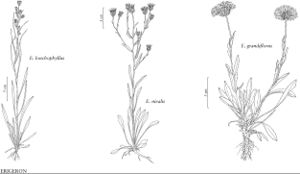Erigeron grandiflorus
Fl. Bor.-Amer. 2: 18, plate 123. 1834.
Perennials, 2–25 cm; rhizomatous, fibrous-rooted, caudices or rhizomes crownlike or branches relatively short and thick. Stems erect to decumbent-ascending, sparsely to moderately pilose to villoso-hirsute, often stipitate-glandular over all or part. Leaves basal (persistent) and cauline (petioles equaling or shorter than blades); blades oblanceolate to obovate or spatulate, 10–60 (–90) × 3–8 (–14) mm, cauline abruptly or gradually reduced distally, margins entire (apices rounded), faces sparsely hirsutulous or villous to sparsely strigose or glabrate, sometimes sparsely glandular. Heads 1. Involucres 5–8 (–10) × 8–20 mm. Phyllaries in 2–3 series (green or purplish), moderately to densely woolly-villous (hairs flattened, cross-walls sometimes reddish), minutely glandular at least apically. Ray-florets 50–130; corollas blue to pink or purplish, rarely white, 7–11 (–15) mm (mostly 1–2 mm wide), laminae coiling. Disc corollas 2.4–4 (–5) mm. Cypselae 1.8–2.4 mm, 2-nerved, faces strigose; pappi: outer of setae, inner of (7–) 10–18 (–22) bristles. 2n = 18, 27.
Phenology: Flowering Jul–Aug(–Sep).
Habitat: Rocky sites, meadows, alpine or near timberline
Elevation: 2900–4200 m
Distribution

Alta., B.C., Ariz., Colo., Idaho, Mont., N.Mex., Oreg., Utah, Wyo.
Discussion
S. A. Spongberg (1971) recognized only the triploid populations as Erigeron grandiflorus and assigned the diploid ones to E. simplex. He hypothesized that the triploids incorporate genomic elements from an ancestor other than E. simplex. Based on his comments and annotations, however, triploids in southern Canada and the western United States apparently differ from the much more widespread diploids only quantitatively, having involucres and florets at the higher end of size ranges. Morphologic distinctions between the ploidal races do not provide a basis for consistent distinction. Spongberg (p. 200) also noted that “because of the intergrading of morphologic features of plants of Erigeron grandiflorus...the single most important criterion indicative of this taxon is highly irregular [in shape] and greatly abortive pollen.” These pollen features result from meiotic anomalies associated with the triploid condition.
Specimen citations by A. Cronquist (1947) for Erigeron grandiflorus were mostly from collections of the species treated here as E. porsildii. He also cited two collections from southwestern Alberta; those and the type collection of E. grandiflorus (from the same region) are disjunct by more than 1500 kilometers from the more northern range of E. porsildii and instead lie at the northern extremity of the range of what previously has generally been identified as E. simplex.
Selected References
None.
Lower Taxa
"thick" is not a number.
